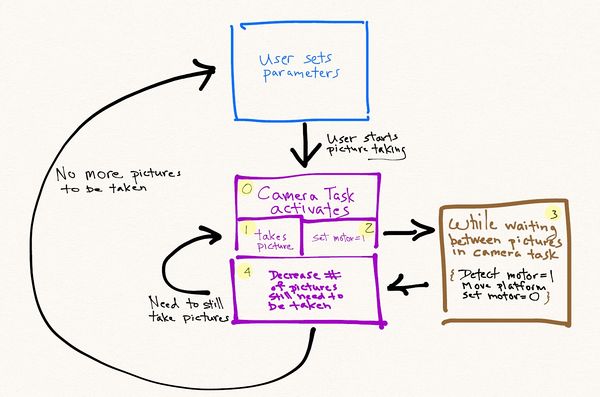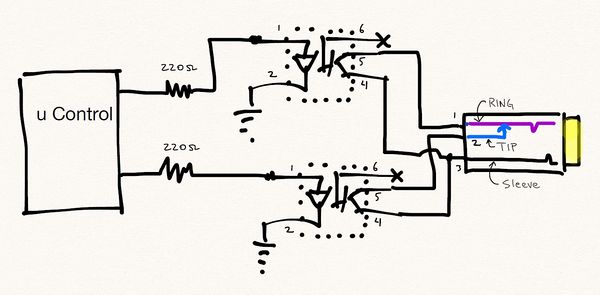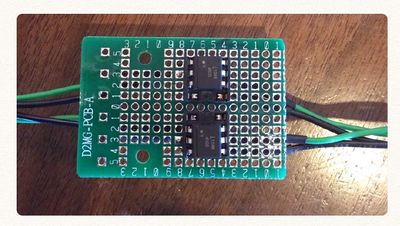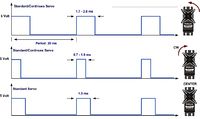F13: Bulb Ramper
Contents
Grading Criteria
- How well is Software & Hardware Design described?
- How well can this report be used to reproduce this project?
- Code Quality
- Overall Report Quality:
- Software Block Diagrams
- Hardware Block Diagrams
- Schematic Quality
- Quality of technical challenges and solutions adopted.
Project Title
Bulb Ramper
Abstract
Time-lapse photography is the process of taking many exposures over a long period of time to produce impressive short videos and photos, which create a feeling of traveling quickly through time. While the ability to create time-lapse videos or photos is available to anyone with a camera and a fairly inexpensive with a trigger controller, the ability to increase exposure time (bulb ramping) while moving the camera is not. Moving bulb-ramping device currently on the market cost hundreds of dollars. Our team intends to create a bulb-ramping device that can rotate 360 degrees around and, will trigger the camera shutter in sync with travel and will also have the ability to pan as it travels.
Objectives & Introduction
Objective of the project is to learn the following:
1. Learn about the camera interface and how designs differ in order to protect the circuits inside the camera.
2. Learn how to use the RTOS (Real time OS) system in our software implementation.
3. Learn how motors work and implement into our design.
Team Members & Responsibilities
- Team Member 1
- Driver Development
- Team Member 2
- FreeRTOS Software Design
Schedule
| Week # | Date | Planned Activities | Actual |
| 1 | 10/8/2013 | Develop Proposal | Successfully completed |
| 2 | 10/15/2013 | Acquire Parts
Identify interfaces to be used. Identify pin selections Review datasheets |
· All parts are in
· Interfaces are identified · All datasheets are reviewed |
| 3 | 10/22/2013 | ·Work on the Chassis
Write PWM driver for Servo motor and Integrate the Opto-coupler (camera control) |
·Chassis build up has been completed
PWM Driver has been completed and Integration of Opto-coupler completed |
| 4 | 10/29/2013 | Integrate all the LEDs and Switches
· Work on WIFI Interface |
·Integration is completed successfully
Coding for WIFI has been completed. Able to communicate via wifi to rn-xv chip. Able to send data & receive data. |
| 5 | 11/5/2013 | Work on the FreeRTOS-based firmware. Create four task: Terminal, Camera, Wifi, & Motor related task | After working on FreeRTOS-based firmware, the Terminal, Camera, Wifi and Motor tasks were successfully completed. |
| 6 | 11/12/2013 | Debug and make minor adjustments | Debugging and cleaning up the debug codes were completed and minor adjustments made if needed. Documentation for report started. |
| 7 | 11/19/2013 | System Integration Initial round | The initial phase of integration successfully completed without any major changes to software or hardware. Project report documentation such as design flow diagrams, schematics and project photos generated. |
| 8 | 11/26/2013 | System Integration Final round
Complete and revise project report |
Final phase of integration was successfully completed which included testing with multiple test parameters and extreme conditions. |
| 9 | 12/3/2013 | Finalize and deliver project
Demo project |
Parts List & Cost
| Part Number# | Description | Cost | Quantity |
|---|---|---|---|
| 4N35 | Optocoupler used to isolate the power | $5.0 | 2 |
| LEDs | used for various application of the program | $0.5 | 1 |
| BOB-11978(Sparkfun) | Logic Level Converter(5V to 3.3V or 3.3V to 5V) | $1.95 | 1 |
| GWServo-S04BBM | Servo Motor | $0.0 | 2 |
| RN-XV WiFly Module | The RN-XV module by Roving Networks used Wi-Fi communication. | $35.00 | 1 |
| Revolving display Acylic | Plastic Revolving display base used as rotating platform | $20.00 | 1 |
| LPC1758 SJSU CMPE BOARD (SJSU) | Processor LPC1758 SJSU CMPE BOARD | $75 | 1 |
Design & Implementation
The software flow is detailed up top. The general flow has the user setting each variable (# of pictures to take, motor movement, shutter time, etc). After which, the program will automatically take pictures and move on their own until the required pictures have been taken.
As part of the flow process, there is a loop that is repeated in order to repeatedly take pictures and move the camera platform.
Hardware Design
Camera Control
Interfacing with the camera utilized was done via a 3.5mm stereo jack which is connected to the camera N3 port. This is the standard interface of numerous Canon cameras. The 3.5mm stereo jack has three points of contacts on the connector, an outer ring, the middle ring and the tip. Shorting the middle ring to the outer ring triggers the cameras focus, while shorting the tip to the outer ring triggers the cameras shutter. Creating the connection for the required operations is done by way of using two optocouplers as switches. The order of operation for triggering the camera properly is to first engage the focus, engage the shutter then disengages both the shutter and focus. The circuit interface to the camera is displayed above.
The 220 ohm resistor has been selected to provide ~15mA (3.3v GPIO out from SJSU board divide by 220 ohm) going into 4N35 opto-coupler. The purpose of the opto-coupler is not only to transfer electrical signals between two isolated circuits by using light but also to serve as a protecting mechanism to prevent high voltage from going into the camera.
Picture of 4N35 in our hardware:
Hardware Interface
There are two main interfaces for our project:
1. GPIO: GPIO is used for camera activation. It takes two GPIO ports in order to activate the camera shutter. One GPIO to focus and and the other GPIO to open the shutter.
2. PWM output:
PWM, or Pulse Width Modulation, was used to control the 180-degree positional servo. The servo expects a train of pulses of varying widths. The pulses are repeated at a given period, typically set at 20 ms (50Hz). The width of the pulse is the code that signifies to what position the shaft should turn. The center position is usually attained with 1.3-1.5ms wide pulses, while pulse widths varying from 0.7-1ms will command positions all the way to the right (left), and pulse widths of 1.7-2ms all the way to the left (right). However, we found that the valid pulse widths were larger, ranging from 0.2 ms to 3.3 ms in our servo. Therefore, we expanded the range of pulse widths and converted the range into a degree range in software. The servo is connected to a 6V power supply and is controlled by PWM1 (P1.0)
In this section, you can describe how your hardware communicates, such as which BUSes used. You can discuss your driver implementation here, such that the Software Design section is isolated to talk about high level workings rather than inner working of your project.
Software Design
For our project, there are four different tasks: 1. Terminal Task: The terminal task is responsible for providing the input and output of the program. It is responsible for displaying data and modifying variables when the user wishes to change it. For example, the terminal task will allow the user to change the number of the pictures or time between pictures being taken.
As such, it contains the main code for displaying the different menus and the code to change variables according to user input.
2. Wifi Task: This sets the necessary parameters to connect to a router or another computer.
3. Camera Task: Main function of this task is to take pictures according to what the user inputted.
4. Motor Task: Provides the functionality to drive the motor to different positions.
Show your software design. For example, if you are designing an MP3 Player, show the tasks that you are using, and what they are doing at a high level. Do not show the details of the code. For example, do not show exact code, but you may show psuedocode and fragments of code. Keep in mind that you are showing DESIGN of your software, not the inner workings of it.
Implementation
There are several design decisions made during the implementation of the project. We shall first go over the project design for each individual part and then describe the overall system integration.
1. As part of the project, we wanted to work with wireless communication because it is one of the most common methods for communication between two devices. That is why we picked the wi-fly chip for our bulb ramper. By using wifi, we can then expand the ways of interacting to the camera device such as a desktop computer or a cell phone.
2. For the camera interface, we used the N3 Canon Port for shutter activation. This was selected compared to USB interface, because it has a long history of usage and the design is simple to implement. We did not want to unnecessary complicate the design unless there was a need. If we went with USB, we would have been able to do "Live View" (stream the camera viewfinder to an external device) but decided against it. For our device, the purpose is to automate the picture taking process, by add "Live View", it does not bring any additional value for the user. For the N3 port, it is standard to use the N3 to Stereo Plug cable as the primary way to trigger the device. What was left was the translation of the signal between the SJSU board to the trigger signal. For that, we use the opto-decoupler. The main reason for the opto-decoupler is to protect the camera from high voltage by isolating the two sources.
3. Motor: For motor interface we used servomotors because of their dynamic performance: their ability to make fast speed and direction changes. In addition servomotors have the following characteristics that make them more reliable and desirable than stepper motors:
• Servomotors usually have a small size • Servomotors have a large angular force (torque) comparing to their size • Servomotors operate in a closed loop, and therefore are very accurate • Servomotors have an internal control circuit • Servomotors are electrically efficient – they required current is proportional to the weight of the load they carry.
Controlling servomotors is achieved by sending a single digital signal to the motor’s control wire. Therefore, we use the PWM, or Pulse Width Modulation signal to control the 180-degree positional servo.
Testing & Technical Challenges
Describe the challenges of your project. What advise would you give yourself or someone else if your project can be started from scratch again? Make a smooth transition to testing section and described what it took to test your project.
Include sub-sections that list out a problem and solution, such as:
My Issue #1
Discuss the issue and resolution. Motor There were some of difficulties at first in implementing the PWM driver. An oscilloscope was used to make sure that the appropriate signals were being sent out because the PWM pin with any dutycycle other than 100% or 0% will show a rising edge. This way it is easy to see whether or not a PWM signal really is being sent. A DMM was also used to check voltage levels to ensure that the appropriate voltage was being applied in each instance.
Wifi There was some difficulty in the beginning trying to get the wifly chip working. The main reason being was the toggle was set to UART 2 instead of UART 3 on the SJSU board.
Camera Control: In the initial breadboarding of the camera circuit, the camera was not triggering on the signal provided by the GPIO. This was primarily due to the 1000 ohm resistor used instead of the 220 ohm resistor in the latest version. The opto-coupler was not given enough power to transfer energy to the other side. By scaling back the resistance to 220 ohm, the camera responded to the camera shutter activation.
Conclusion
Conclude your project here. You can recap your testing and problems. You should address the "so what" part here to indicate what you ultimately learnt from this project. How has this project increased your knowledge?
These design documents describe a functioning time lapse photography device. The majority of the components used for this project were reclaimed materials. This not only kept the cost within reason but gave the project a unique one of a kind look. This method of construction was intentional, hopefully demonstrating that it is possible to create a useful and sophisticated device that utilizes current technology in an environmentally friendly fashion.
Ultimately the device functioned with greater precision and flexibility than had been originally anticipated. After several trial runs a satisfactory time-lapse film was produced. This can be viewed on the course Wiki designated for student projects. The functionality of the device is very flexible allowing a great amount of artistic license in the production of the time-lapse photos.
Project Video
Upload a video of your project and post the link here.
Project Source Code
Send me your zipped source code and I will upload this to SourceForge and link it for you.
References
Acknowledgement
References Used
List any references used in project.
Appendix
You can list the references you used.




